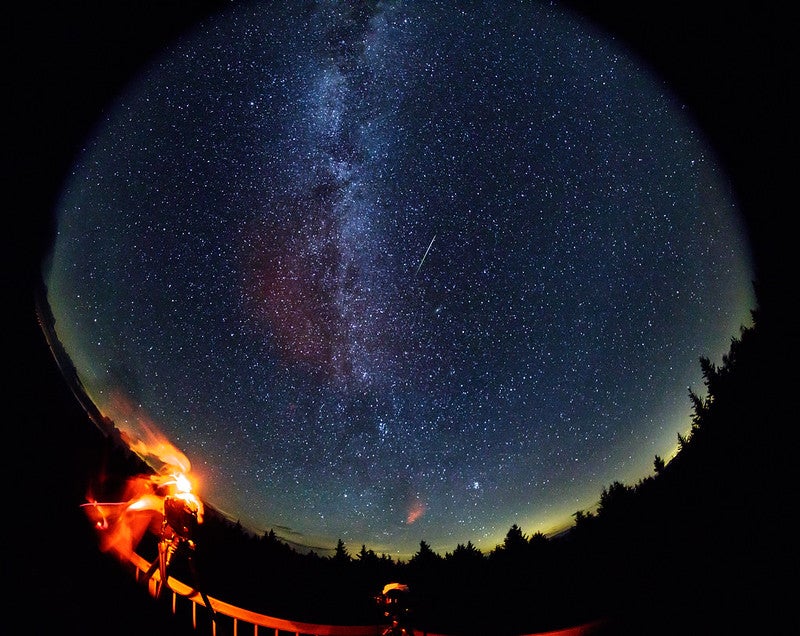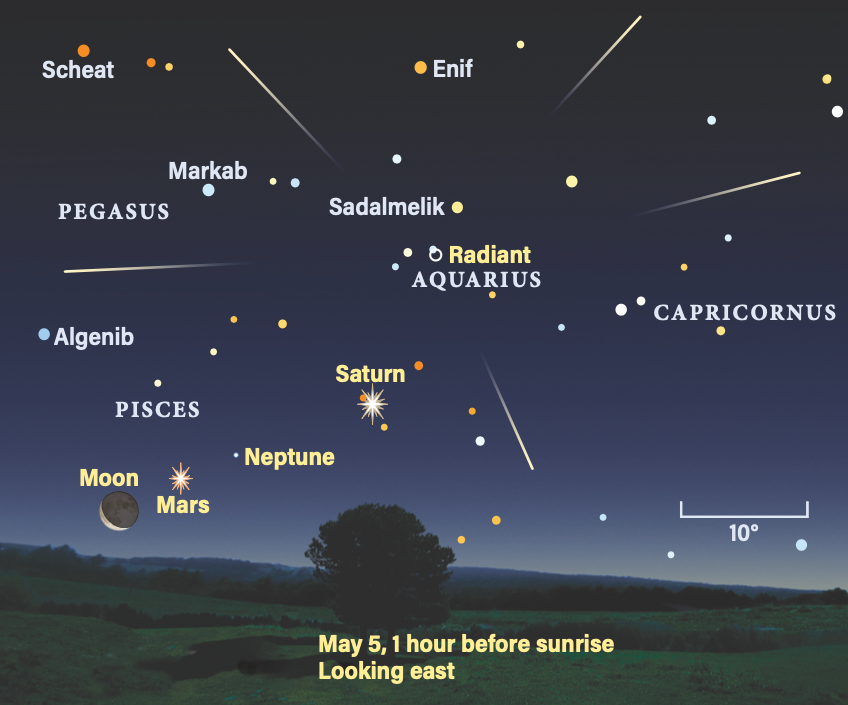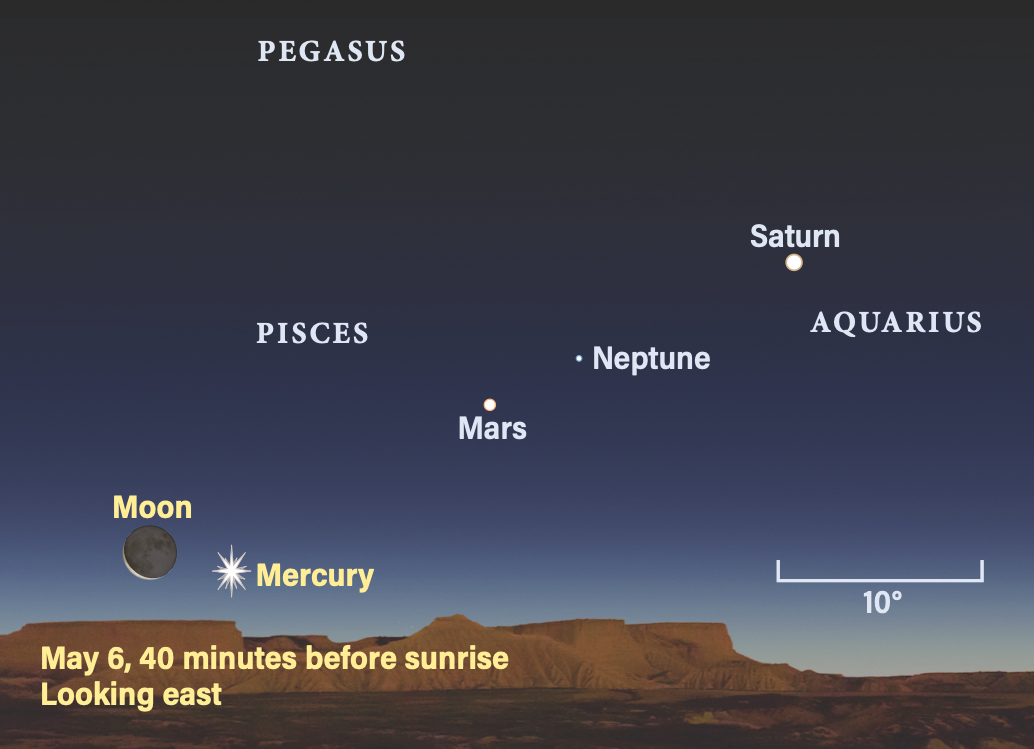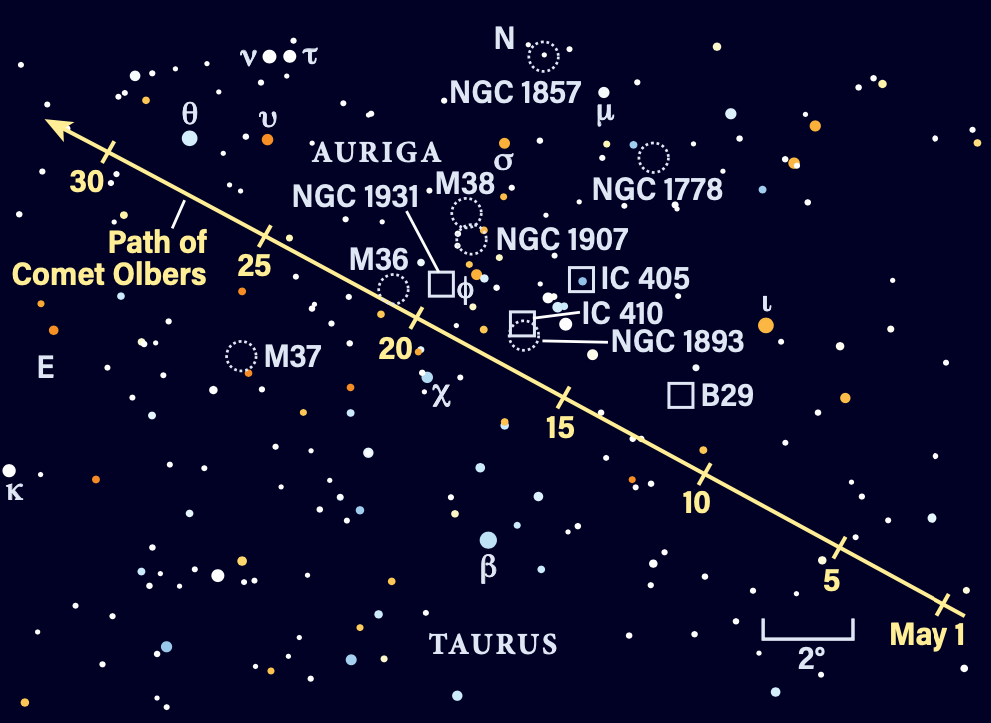
Friday, May 3
The Moon passes 0.8° south of Saturn at 7 P.M. EDT. Because the pair appears in the early-morning sky, stay tuned to catch them tomorrow morning, along with several other planets.
Dwarf planet Pluto reaches its stationary point in Capricornus at 11 P.M. EDT. The region won’t rise until early tomorrow morning, and tracking down this tiny solar system world is a task only for scopes in the larger range — think 10 inches or more. However, imaging techniques could provide enough of a bump for a smaller scope to find it, too.
If you’d like to try, here are some tips: Your go-to drive will be your friend, as it can be difficult to star-hop to such a faint target. And it is faint — Pluto is magnitude 14.5 and located in southwestern Capricornus. The region rises around 2 A.M. local daylight time and is high enough to begin observing an hour or two later. The later in the morning you look for it, the better — though avoid the hour before sunrise, when the sky will start growing lighter. Capricornus reaches about 17° altitude above the southern horizon two hours before sunrise.
Some other tips: The darker your observing location, the better as well. Make sure you align your scope well during setup and use a planetarium program if possible to help you identify your target amid the myriad faint stars surrounding it. If you’re imaging the region, consider coming back over the next few days and taking a series of photographs — Pluto will be the point of light that moved.
Sunrise: 5:57 A.M.
Sunset: 7:57 P.M.
Moonrise: 3:37 A.M.
Moonset: 2:50 P.M.
Moon Phase: Waning crescent (26%)
*Times for sunrise, sunset, moonrise, and moonset are given in local time from 40° N 90° W. The Moon’s illumination is given at 12 P.M. local time from the same location.
Saturday, May 4
The Moon passes 0.3° south of Neptune at 3 P.M. EDT, then passes 0.2° north of Mars at 10 P.M. EDT. Let’s pick things up ahead of time, though, as the three worlds (and more) are currently congregating in the early-morning sky.
An hour before sunrise, the waning crescent Moon stands about 10° high in the east, to the lower right of the Circlet of Pisces. To the Moon’s upper right is Saturn, which Luna passed by last night and now sits some 7° to the ringed planet’s east. Saturn glows at magnitude 1, outshining many of the stars around it.
To the Moon’s lower left, another 9° east along the ecliptic (the line that the planets follow in the sky), is magnitude 1.1 Mars. See if the so-called Red Planet appears reddish to your eye, particularly compared to Saturn, which should look white or even yellow-tinged.
Next, pull out your binoculars or telescope and move back toward the Moon from Mars about 4° west. That should land you on magnitude 7.8 Neptune, the solar system’s faintest and most distant major planet. Spanning just 2″, the ice giant may look more like a “flat,” blue-gray star. You’ll want to catch it earlier in the morning before the sky grows too light with the oncoming sunrise.
You have a little more time to spend with Mars and Saturn. The former spans 5″, while the latter stretches some 16″, with stunning rings that roughly double that width. Saturn now sits just under 1° from the 4th-magnitude star Phi (ϕ) Aquarii, and just northeast of the three 4th- to 5th-magnitude stars Psi1, Psi2, and Psi3 Aqr.
Wait about half an hour and, with half an hour yet to go until sunrise, you may be able to spot magnitude 0.8 Mercury just 3° above the horizon. The thin crescent Moon will pass by the solar system’s smallest planet in two days, so we’ll be back to observe the pairing!
Sunrise: 5:56 A.M.
Sunset: 7:58 P.M.
Moonrise: 4:02 A.M.
Moonset: 4:05 P.M.
Moon Phase: Waning crescent (16%)

Sunday, May 5
The Eta Aquariid meteor shower reaches its peak today. With a waning crescent Moon rising not long before sunrise and shedding minimal light across the sky, conditions are excellent for catching some shooting stars on what’s hopefully a pleasant May morning.
Step outside an hour or two before sunrise and turn your gaze east. At that time, the shower’s radiant — the point from which shower meteors appear to originate on the sky — is some 15° to 25° high. It’s located in Aquarius, above and slightly to the right of the planet Saturn. (Take some time this morning to note how the Moon has moved along the morning line of planets, now standing to the lower left of Mars.)
Once you’ve found the radiant, cast your gaze some 40° to 60° to one side or the other of it. This will help you catch the brightest, longest streaks in the sky as the tiny dust particles left behind by Halley’s Comet burn up briefly in our atmosphere. The predicted maximum zenithal hourly rate for the Eta Aquariids this year is about 50 meteors per hour; since the radiant is still relatively low, however, you can expect about 12 or so meteors per hour. These may not be spread out over time, either, but come in flurries, so spend some time outside and cast your gaze around every so often, as meteors can appear anywhere in the sky.
You can also take some time to admire the Summer Triangle asterism, comprising the stars Vega, Altair, and Deneb. These three stars are high in the east and rising as sunrise approaches. Over time, they will rise later and later, until they appear directly overhead during the overnight hours at the height of summer.
The Moon reaches perigee, the closest point to Earth in its orbit, at 6:04 P.M. EDT. Our satellite will then sit 225,659 miles (363,163 kilometers) away.
Sunrise: 5:55 A.M.
Sunset: 7:59 P.M.
Moonrise: 4:27 A.M.
Moonset: 5:21 P.M.
Moon Phase: Waning crescent (8%)

Monday, May 6
Moving steadily along the morning line of planets, the delicate crescent Moon passes 4° north of Mercury at 4 A.M. EDT. You can catch the pair about 30 minutes before sunrise in the east, when they stand some 4° high.
The Moon is a tiny sliver, with just 4 percent of its nearside lit. However, you may notice that you can still make out the rest of Luna’s face, albeit in dimmer, grayer light. This is called earthshine, and is reflected sunlight bouncing off Earth and lighting up the portion of the Moon already in our planet’s shadow.
Mercury now sits to the Moon’s lower right and shines at magnitude 0.7. Through binoculars or any telescope, the tiny world spans 9″ and appears some 36 percent lit. Far to its upper right lie Mars and then Saturn, both visible to the naked eye, while Neptune also remains in place, though the latter requires those binoculars or a telescope to see and will be difficult in the growing twilight. Venus is currently rising shortly before the Sun and is approaching superior conjunction early next month, rendering it invisible — though it’s still strung along the same line of planets, even if we can’t enjoy it.
Sunrise: 5:54 A.M.
Sunset: 8:00 P.M.
Moonrise: 4:53 A.M.
Moonset: 6:37 P.M.
Moon Phase: Waning crescent (3%)
Tuesday, May 7
New Moon occurs at 11:22 P.M. EDT, leaving the entire night and morning dark for observing. It’s also the perfect time for Northern Hemisphere residents to try to catch a glimpse of the zodiacal light after sunset, sometimes called the false dusk.
Head outside shortly after sunset as the sky is growing dark. You’ll want to pick a viewing location where the western horizon is dark and clear of city light domes. The darker your sky, the better the zodiacal light’s faint glow will stand out. As darkness falls, look for a white, cone-shaped glow extending above the horizon, reaching up through Taurus and into Gemini. This light is generated by sunlight glinting off myriad tiny dust particles in the inner solar system, all left behind by the passage of comets. While coherent streams of these particles are what cause meteor showers like the Eta Aquariids, over time much of this dust settles along the ecliptic — the plane of the solar system — and causes the zodiacal light.
Early May is one of the last best chances to catch the spring apparition of this phenomenon; in the autumn, the zodiacal light will appear in the pre-dawn eastern sky instead and is sometimes called the false dawn.
Sunrise: 5:52 A.M.
Sunset: 8:01 P.M.
Moonrise: 5:21 A.M.
Moonset: 7:56 P.M.
Moon Phase: New
Wednesday, May 8
Mars reaches perihelion — the closest point to the Sun in its orbit — at 7 A.M. EDT. At that time, the Red Planet will sit 128.4 million miles (206.6 million km) from our star.
As earlier this week, you can catch Mars in the pre-dawn sky, some 7° above the eastern horizon an hour before sunrise. The Red Planet still glows at magnitude 1.1.
But now, turn southwest to find not Mars, but its rival: the star Antares in Scorpius. This red giant glows at exactly Mars’ current magnitude — 1.1 — and carries the same ruby-red hue as the planet as well. However, the planet’s color comes from sunlight bouncing off its rust-colored surface, while Antares glows red because although it is a massive star, it has grown cooler with age. It is now several thousand degrees cooler than the Sun, which glows a warmer yellow. Antares contains more than a dozen times our Sun’s mass and its diameter would stretch out to roughly the far edge of the main asteroid belt if the star was dropped into the Sun’s spot in our solar system.
Given its mass, Antares will certainly end its life in a supernova explosion someday — and soon, perhaps within the next million years, according to the late stellar expert James Kaler.
Sunrise: 5:51 A.M.
Sunset: 8:02 P.M.
Moonrise: 5:54 A.M.
Moonset: 9:13 P.M.
Moon Phase: Waxing crescent (1%)
Thursday, May 9
Mercury reaches its greatest western elongation (26°) from the Sun at 6 P.M. EDT; however, the planet remains low in the Northern Hemisphere due to the low angle of the ecliptic to the horizon. The view is best for Southern Hemisphere observers. All skywatchers can catch the innermost planet early in the morning, rising about 50 minutes before the Sun. By half an hour before sunrise, Mercury stands 4° high in the east and shines at magnitude 0.5, forming the lowest point in the planetary lineup visible in the early-morning sky.
If you prefer evening observing, let’s visit Corvus the Crow in the south an hour after sunset. This small constellation hangs below the western part of Virgo, to the lower right of the Maiden’s brightest star, magnitude 1 Spica. Delta (δ) Corvi lies 14.5° southwest of Spica and, through a small scope, resolves into two stars: a 3rd-magnitude, blue-white primary and a 9th-magnitude, orange-hued secondary. With a healthy separation of some 24″, their individual colors should be easy to make out.
Delta is one of four stars that makes up the Crow’s main body. The other three are 3rd-magnitude Gamma (γ) to Delta’s lower right; 3rd-magnitude Epsilon (ϵ) below Gamma; and 3rd-magnitude Beta (β) hanging directly below Delta, to Epsilon’s lower left.
Sunrise: 5:50 A.M.
Sunset: 8:03 P.M.
Moonrise: 6:34 A.M.
Moonset: 10:27 P.M.
Moon Phase: Waxing crescent (3%)

Friday, May 10
Comet 13P/Olbers is working its way up through Auriga, standing tonight just inside that constellation’s southern border near Taurus. You can find the comet, currently around 9th magnitude, by working your way 5° west-northwest of Elnath, the tip of Taurus’ rightmost horn as the Bull sinks in the western sky after sunset.
Over the course of May, Olbers will continue through Auriga, heading for magnitude 2.7 Bogardus (Theta [θ] Aurigae) and skimming close to this star later in the month. Along the way, it passes plenty of stunning deep-sky objects, offering imagers some great opportunities.
One of those objects is IC 410, also known as the Tadpole Nebula. This star-forming region lies just under 5° north of Elnath and 5° north-northeast of Comet Olbers tonight. The nebula spans an impressive 40′ at its widest and encompasses the young open cluster NGC 1893. This region looks great even through small scopes, particularly if you slide a nebula filter in place. Practice taking some photos of it now — around midmonth, Olbers will pass near the nebula, setting up a perfect shot.
Sunrise: 5:49 A.M.
Sunset: 8:04 P.M.
Moonrise: 7:22 A.M.
Moonset: 11:33 P.M.
Moon Phase: Waxing crescent (9%)

Sky This Week is brought to you in part by Celestron.









